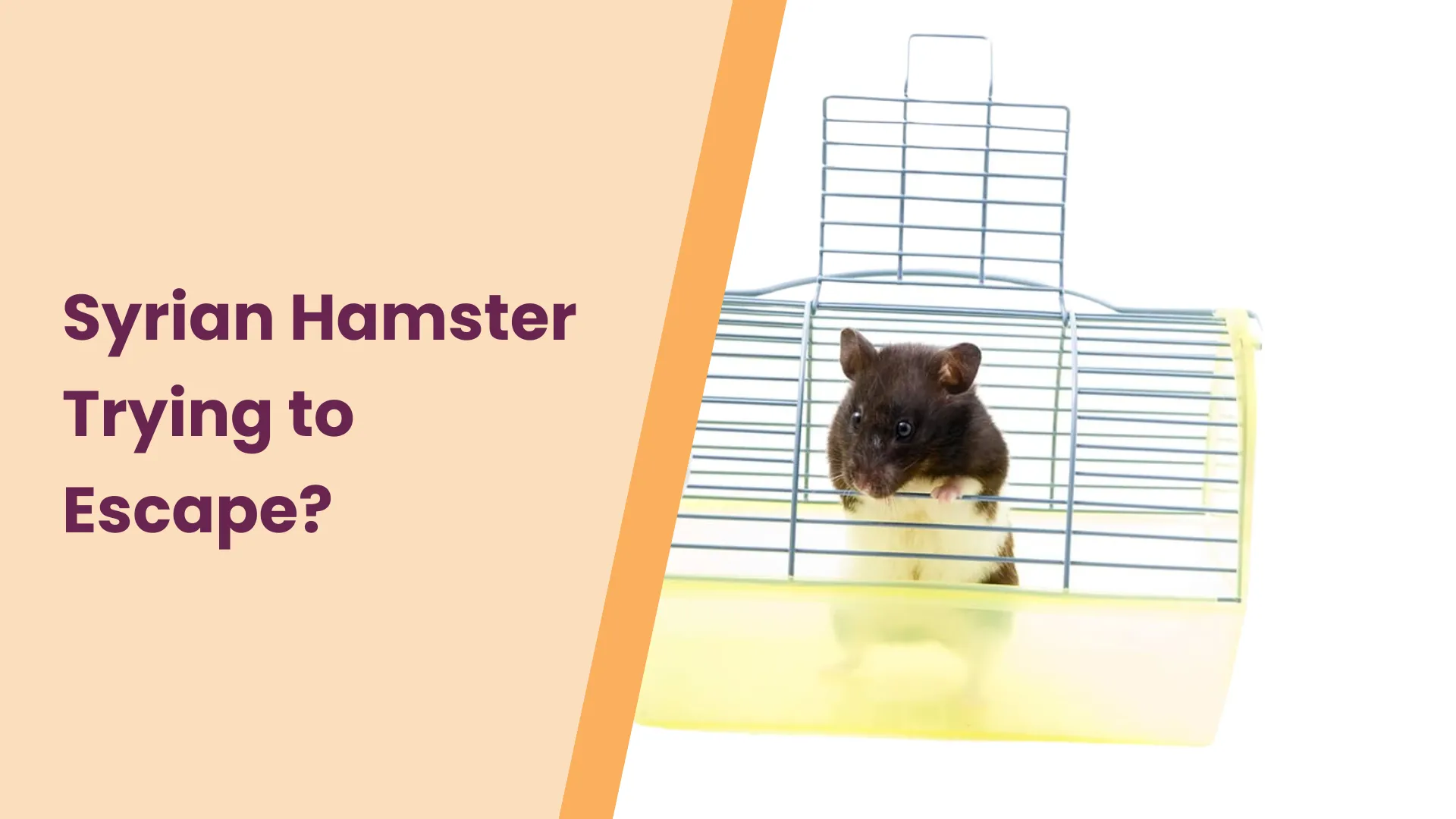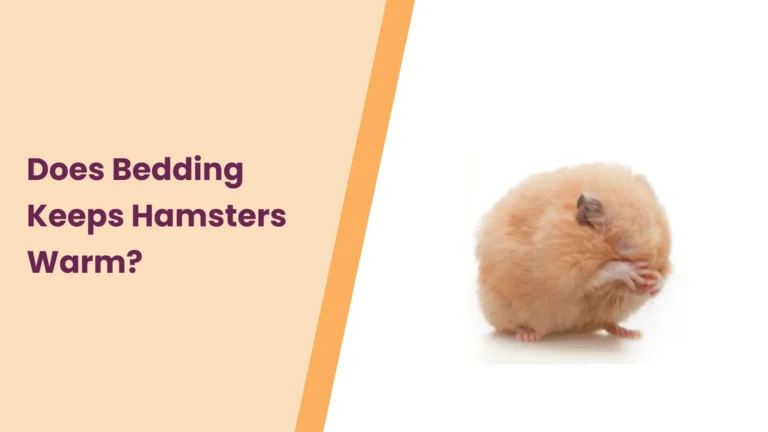Syrian Hamster Keeps Trying To Escape? – Here’s What To Do!
Meet Max, my mischievous Syrian hamster. Max may be tiny, but he possesses a giant-sized determination when it comes to escape artistry. It’s not uncommon to find him plotting daring escapes from his cozy cage.
If you’re a fellow hamster enthusiast facing similar Houdini-like antics, you’re not alone. In this blog post, we’ll explore the world of Syrian hamsters, their innate tendencies, and the reasons behind their great escape missions. We’ll also uncover the secrets to keeping Max and his furry friends content, safe, and entertained in their cages.
So, let’s embark on this journey to understand and address the captivating conundrum of hamsters on the run.
Understanding Hamster Behavior: Unveiling the Great Escape Mystery
Our adorable furry friends, like Max, are not just tiny bundles of fluff; they’re also born adventurers. Understanding the motivations behind their escape attempts is the first step to addressing this perplexing behavior.

a. The Instinct to Roam: Hamsters, including Syrian hamsters, hail from the wild, where they have vast territories to explore. This natural instinct to roam, scavenge, and seek out new territory is deeply ingrained in their DNA. In the confines of a cage, they may feel the itch to venture beyond, much like a seasoned explorer yearning for new horizons.
b. Stress and Boredom: Think of your hamster’s cage as their world. When this world lacks stimulation, they might feel stressed and, well, bored. These emotions can manifest as an overwhelming desire to escape. Signs of stress include excessive gnawing, pacing, or even signs of aggression.
c. Species Matters: Different hamster species have varying needs and behaviors. Syrian hamsters, for instance, are solitary creatures and can become territorial if they feel cramped in their space. Knowing your hamster’s species is vital for understanding their specific behaviors and addressing escape tendencies.
Intrigued by the enigmatic world of our tiny companions? You’re not alone. To keep your hamster content and deter them from seeking the great outdoors, let’s delve into the details of cage essentials, stress relief, and hamster-specific tips in the sections to come.
Cage Essentials: Crafting a Secure Hamster Haven
Your Syrian hamster’s cage is their sanctuary, their fortress, and the key to keeping those escape attempts at bay. Let’s explore the must-haves for creating a secure haven that’ll make Max want to stay put.
1. Size Matters
First and foremost, the size of the cage is crucial. Syrian hamsters are not only adorable but also larger than some other hamster species. To ensure they have enough room to roam and explore within their home, opt for a spacious cage. A recommended minimum is around 360 square inches of floor space. This ample space mimics their natural habitat, reduces stress, and discourages escape attempts.
2. Bar Spacing and Materials
The bars of the cage play a pivotal role in thwarting escape efforts. Ensure that the spacing between the bars is narrow enough to prevent your hamster from squeezing through. A bar spacing of around 1/2 inch is generally ideal. Additionally, opt for a cage made of sturdy, chew-resistant materials to deter any gnawing attempts.
3. Bedding and Nesting Material
Hamsters love to burrow and create cozy nests. Providing a deep layer of bedding, like aspen shavings or paper-based bedding, allows them to express this natural behavior. The right bedding not only keeps them content but also reduces the chances of boredom-driven escapes.
4. Hideouts and Enrichment
Enriching your hamster’s environment is a surefire way to keep them content and engaged. Add hideouts, tunnels, and platforms for exploration. Hamsters love to climb and hide, so these additions can satisfy their curiosity and decrease escape attempts.
Remember, your hamster’s cage is their kingdom, and the more comfortable and stimulating you make it, the less likely they’ll want to venture beyond its confines. In the next sections, we’ll dive deeper into stress relief, Syrian hamster-specific tips, and ways to identify potential escape routes.
Signs of Stress and Boredom: Deciphering Your Hamster’s Messages
Just like us, our Syrian hamsters experience emotions, including stress and boredom. To keep their escape missions in check, it’s essential to recognize the signs when they’re trying to tell us something’s amiss.
a. Excessive Gnawing: If you notice your hamster gnawing persistently on cage bars or accessories, it might not be a craving for destruction. Instead, it could be a cry for help. Hamsters gnaw to keep their teeth at a healthy length, but excessive gnawing can indicate that they’re stressed or bored. Providing appropriate chewing toys can redirect this energy.
b. Pacing and Restlessness: Just like humans, hamsters can become restless when they’re feeling anxious or unstimulated. If you see your furry friend pacing back and forth in their cage, it’s time to consider their environment and add some entertainment options. Pacing often indicates a yearning for more space or activities.
c. Aggressive Behavior: Hamsters are typically docile, but stress or boredom can trigger aggression. If your hamster becomes unusually nippy or confrontational, it’s a red flag. Check their surroundings, ensure they have enough hideouts, and engage in bonding activities to ease their stress.
d. Excessive Sleeping: While hamsters do need their beauty rest, excessive sleeping during active hours could indicate boredom or a lack of mental stimulation. Adding new toys or rearranging their cage setup can help invigorate their interest in their surroundings.
Understanding your hamster’s emotions and signals can help prevent escape attempts that stem from stress and boredom. In the upcoming sections, we’ll explore enrichment strategies and hamster-specific tips to make their world a more enjoyable place.
Enrichment and Play: Banishing Boredom from Your Hamster’s World
To deter your Syrian hamster from plotting daring escapes, it’s crucial to keep their inquisitive minds and busy paws engaged. Let’s explore the art of hamster entertainment and the playtime that’ll have your little escape artist captivated.
a. The Magic of Toys: Hamsters are avid explorers and love to interact with their environment. Invest in a variety of hamster-safe toys. Consider options like tunnels, wheels, chew toys, and puzzle feeders. These enriching elements not only provide mental stimulation but also satiate their natural instincts to gnaw and burrow.
b. Homemade Hide-and-Seek: Crafting DIY hamster toys can be a fun and budget-friendly way to keep your pet engaged. Cardboard tubes, paper bags, and even toilet paper rolls can transform into exciting playthings. Be sure to supervise your hamster during these activities to ensure their safety.
c. Rotating the Scenery: Change the layout of your hamster’s cage periodically. A new arrangement can spark their curiosity and make their environment feel fresh and exciting. Introduce different hideouts, climbing structures, or even scatter some treats for them to discover.
d. Bonding Through Play: Don’t underestimate the power of bonding with your hamster through play. Use gentle handling and positive interactions to strengthen the trust between you and your furry friend. Hand-feeding treats or allowing them to explore outside their cage (in a safe, hamster-proofed area) can be rewarding experiences for both of you.
By embracing these enriching activities and playtime, you’ll ensure your hamster remains content, mentally stimulated, and less inclined to attempt those escape missions. In the following sections, we’ll explore species-specific tips and the art of identifying potential escape routes in their cage.
Syrian Hamster-Specific Tips: Catering to Your Unique Escape Artist
Syrian hamsters, often known as Teddy Bear hamsters, have their distinct characteristics and needs. Understanding these quirks is essential for preventing escape attempts and ensuring your furry friend’s well-being.
a. Solitary Creatures: One key feature of Syrian hamsters is their solitary nature. Unlike some other hamster species, they prefer to live alone. Placing them with another hamster can lead to conflicts, stress, and potentially more escape attempts. Be sure to provide a spacious cage for your solitary explorer.
b. Territorial Tendencies: Syrian hamsters are territorial by nature. They have a strong attachment to their living space. So, make their cage their kingdom. Regularly clean and maintain it to keep them comfortable. A clean and well-maintained habitat reduces stress and the desire to escape.
c. Larger Size, Bigger Space: Syrian hamsters are larger compared to other hamster breeds. This means they need more room to move around and exercise. A spacious cage equipped with ample toys and hideouts ensures they have the space they need to explore and play.
d. Beware of Heat: Syrian hamsters are sensitive to temperature changes. Ensure their living area is in a cool, well-ventilated spot, away from direct sunlight or drafts. Maintaining a comfortable temperature will keep your hamster content and less inclined to escape in search of better conditions.
Remember, every hamster is an individual with its own personality, and understanding the specific needs of your Syrian hamster will go a long way in preventing escape attempts and ensuring a happy and secure home. In the upcoming sections, we’ll focus on identifying escape points and proactive measures to secure the cage.
Identifying Escape Points: Staying One Step Ahead of Your Crafty Hamster
To prevent your Syrian hamster’s escape missions, you’ll need to think like an escape artist and identify the potential exit points in their cage. Let’s play detective and ensure their home remains secure.
a. Small Gaps and Weak Spots: Begin by inspecting the cage’s structure for any weak points or gaps that your clever hamster might exploit. Pay close attention to the cage bars, latches, and the corners of the cage. Even the tiniest opening can be an opportunity for escape.
b. The Tunneling Trap: Syrian hamsters are known for their digging tendencies. Check for tunnels or burrows they may be creating near the corners of their cage. If they’re burrowing close to the cage walls, it could be an indication of their escape plans.
c. Door Doubt: Cage doors are a prime escape route. Ensure that the cage doors are securely latched, and the locks are in good working condition. Some hamsters are incredibly skilled at manipulating simple latches, so investing in a lock that’s hamster-proof might be a wise choice.
d. Unseen Climb Spots: Hamsters are fantastic climbers. Check for any accessories or cage furniture that your hamster can use to scale the walls or reach the cage’s lid. Remove or secure such items to avoid surprise escapes.
By putting on your detective hat and being thorough in your inspection, you can proactively prevent escape attempts. In the following section, we’ll delve into practical measures for preventing escapes and keeping your furry friend safe and sound.
Preventing Escapes: Crafting a Hamster-Proof Fortress
We’ve explored the inner workings of your Syrian hamster’s escape strategies, but now it’s time to turn the tables. Let’s discuss practical measures to fortify their cage, making it a secure fortress against any escape plot.
a. Double-Check Cage Locks: Start by ensuring all cage locks and latches are in perfect working order. Some hamsters possess remarkable dexterity, and they can easily manipulate simple locks. Consider investing in lock mechanisms designed to outsmart even the most clever hamsters.
b. Bar Blockers and Bar Spacing: To prevent squeezing through the bars, consider using bar blockers or mesh screens on the cage. These accessories add an extra layer of security. Measure the bar spacing carefully, ensuring it’s too narrow for your hamster to pass through.
c. Lid Security: Most cages have lids that can be removed for cleaning or feeding. Ensure the lid is secure and latched properly, leaving no room for your hamster to lift it. Some hamsters have been known to push lids open, so a secure latch is essential.
d. Regular Cage Maintenance: A clean and well-maintained cage is a happy hamster’s home. Regularly inspect the cage for any wear and tear, and promptly replace or repair any damaged parts. This maintenance prevents weak spots that could become potential escape routes.
By taking these steps, you can create a virtually escape-proof environment for your Syrian hamster. In the next section, we’ll delve into the importance of handling and bonding, strengthening the trust between you and your furry friend.
Handling and Bonding: Strengthening the Trust with Your Syrian Hamster
Building a strong bond with your Syrian hamster can be the key to reducing stress, preventing escape attempts, and ensuring a contented and happy pet. Let’s dive into the art of handling and bonding.
a. Gentle and Patient Approach: When it comes to handling your hamster, a gentle and patient approach is essential. Syrian hamsters can be shy and may need time to acclimate to human interaction. Start by offering your hand near the cage, allowing them to approach you on their terms.
b. Treat Time: A delicious way to win your hamster’s heart is through treats. Hand-feeding them small, hamster-safe treats can create a positive association with your presence. Just be sure to choose treats that are healthy and appropriate for hamsters.
c. Frequent, Short Interactions: Frequent, short interactions are often more effective than infrequent, lengthy sessions. Spend a few minutes with your hamster each day, gradually extending the time as they become more comfortable with your presence.
d. Controlled Exploration: To build trust, you can allow your hamster to explore outside their cage in a controlled, hamster-proofed environment. Supervised exploration time can be an enriching experience for your pet and help strengthen your bond.
e. Respect Their Boundaries: It’s crucial to respect your hamster’s boundaries. If they show signs of stress or discomfort, like hiding or becoming agitated, it’s best to give them space. Over time, their trust in you will grow, and they’ll become more comfortable with handling.
Bonding with your Syrian hamster not only reduces their desire to escape but also creates a deep and fulfilling connection between you and your pet. In the following section, we’ll discuss the signs of a happy and content hamster and when to seek professional help.
Seeking Professional Help: When Your Hamster Needs a Helping Hand
While our love and care can work wonders for our Syrian hamsters, there may come a time when professional guidance is necessary. Let’s explore when to seek the assistance of a veterinarian or hamster expert.
a. Unusual Behavior or Health Issues: If your hamster displays unusual behavior, such as persistent stress, excessive hiding, or sudden aggression, it’s essential to consult a veterinarian who specializes in exotic pets. These behaviors could be signs of underlying health issues that require attention.
b. Ongoing Escape Attempts: If your hamster’s escape attempts persist despite your best efforts, it may be time to consult a hamster expert. They can provide insights into your pet’s unique needs and offer solutions tailored to your hamster’s behavior.
c. Cage and Environment Review: A professional can also assess your hamster’s cage and living environment to ensure it meets the highest standards of safety and enrichment. They may recommend modifications or upgrades to better suit your pet’s needs.
d. Behavioral Training and Enrichment Ideas: Hamster experts can provide valuable advice on behavioral training and suggest enrichment ideas that cater to your hamster’s unique personality. This guidance can go a long way in reducing escape attempts and ensuring your pet’s well-being.
Remember, seeking professional help is a responsible and caring step to take when your hamster’s health and happiness are at stake. By working alongside experts, you can offer the best care for your beloved Syrian hamster. In the next section, we’ll wrap up our journey through the world of Syrian hamster care.
Conclusion
In the captivating world of Syrian hamster care, understanding your little escape artist’s behavior is the key to a happy and secure home. Max, our adventurous hamster, has shown us that the art of preventing escapes goes hand in paw with providing a welcoming and engaging environment. By embracing their unique traits, bonding through play, and being vigilant in securing their cage, we can outsmart even the most determined escape artists.
Remember, your hamster’s well-being is at the heart of every measure we’ve explored. From identifying potential escape routes to seeking professional guidance when needed, our journey has taken us on a path toward a harmonious life with these charming creatures.
Let’s not forget that, while Syrian hamsters may yearn for freedom, they also seek our companionship. With the right care, our furry friends can thrive in a world that’s safe, stimulating, and escape-proof. Thank you for joining us in unraveling the mysteries of Syrian hamster care. As we bid adieu, may your hamster’s kingdom remain a fortress of joy and contentment.
“We hope this journey into the world of Syrian hamster care has been both insightful and enjoyable for you. But the conversation doesn’t have to end here! We’d love to hear from you. Have you had your own escapade with a Syrian hamster? Do you have tips, stories, or questions to share? Feel free to drop us a comment below, and let’s exchange experiences and insights.
And if you’ve found this article helpful, consider sharing it with your fellow hamster enthusiasts on your favorite social platforms. Together, we can create a thriving community dedicated to the well-being of our beloved Syrian hamsters. Your engagement is not only welcome but cherished.” – Hamsterpit.







